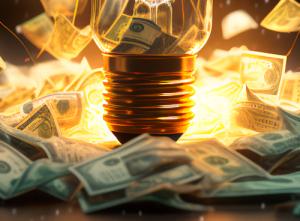Where's Affordability

Getting by has not been affordable for many American households. Including the two, three, or four percent of all their bills that typically goes to pay for electricity.
Which raises some important questions. One is, where’s affordability – or the lack thereof – heading now?
When the highly respected University of Michigan Surveys of Consumers asked in December, is your current financial situation better, the same, or worse compared with a year ago, thirty-three percent said it was better, versus forty-five percent who said it was worse.
That’s not a terrific ratio historically. Though it’s not a terrible one either. In June 2022, for instance, a month when inflation year-over-year was peaking at nine percent, only twenty-five percent of the surveyed consumers said their current financial situation was better, versus fifty-three percent who said it was worse.
Compare that to how consumers were feeling right before the pandemic. In February 2020, fifty-eight percent said their financial situation was better, versus seventeen percent who said it was worse.
U of Michigan’s Index of Consumer Sentiment was 69.7 overall in December. 67.0 for families with income under a hundred thousand. And 74.8 for those with incomes over a hundred thousand. The Index had fallen to as low as 50.0 overall in June 2022.
Notably, like so many other topics, there was a substantial political divide. The Index in December was 86.0 for Democrats, versus 49.0 for Republicans.
The Federal Reserve Bank of St. Louis reports that the delinquency rate on consumer loans was 2.53 percent as of July 1, 2023, the most recent data. That rate is not much different than the 2.47 percent right before the pandemic, as of January 1, 2020.
The delinquency rate at present is much lower than during the 2007 to 2011 period of the great recession, when the delinquency rate reached 4.85 percent. It is at present higher than in mid-2021 when consumers had received checks from the government and had underspent during the pandemic’s peak.
Inflation persists though not as fiercely as in 2022. The Fed’s fight against inflation is being felt by many households. For example, the finance rate on personal loans, per the St. Louis Fed, was at 12.35 percent on November 1, 2023. It was 8.73 percent on May 1, 2022.
The finance rate on new car loans was 8.51 percent on November 1, 2023. It was 4.58 percent two years earlier, on November 1, 2021. And the interest rate on credit cards was 22.75 percent on November 1, 2023. It was 15.91 percent on February 1, 2021.
Nonetheless, consumer expenditures per capita, after adjusting for inflation, continues to rise as it almost always does historically. On July 1, 2023, it was up 1.7 percent year-over-year. And on July 1, 2022, it was up 1.5 percent year-over-year.
Indeed, since July 1, 2011, consumer expenditures per capita, after adjusting for inflation, decreased in only three of the forty-nine calendar quarters of data. Two of the three were right before and at the start of the pandemic. The third was a small one-tenth drop on January 1, 2022.
That’s it. In the remaining forty-six calendar quarters since the great recession, consumer expenditures, even when population growth and inflation are taken out of the equation, have grown. A big reason why paying for electricity has generally been a shrinking percentage of consumer expenditures.
The U.S. Census Bureau reports that sales by retail and food services — excluding gasoline stations — grew 4.7 percent in 2023, as compared with 2022. Including 11.3 percent for food services and drinking places, 8.5 percent for health and personal care stores, and 8.0 percent for nonstore retailers (think Amazon, etc.).
Since inflation came in at 3.4 percent year-over-year in December, the growth in consumer expenditures is once again outpacing inflation. A broad range of the goods and services consumers need and want are evidently becoming more affordable.
For the average consumer. Though of course not for every consumer, hardly, with many remaining hard-pressed.



